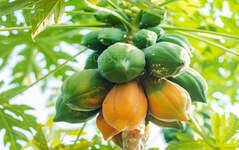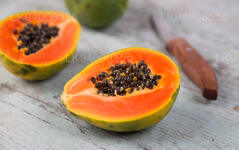
Fruits
Sri Lanka boasts a vibrant array of tropical fruits that reflect its rich agricultural heritage. Among the most beloved is the king coconut (thambili), cherished for its sweet, refreshing water, perfect for quenching thirst in the tropical heat.
Papaya ෴ පැපොල්
Papaya, (Carica papaya), also called papaw or pawpaw, succulent fruit of a large plant of the family Caricaceae. Though its origin is rather obscure, the papaya may represent the fusion of two or more species of Carica native to Mexico and Central America. Today it is cultivated throughout the tropical world and into the warmest parts of the subtropics. The papaya fruit is slightly sweet, with an agreeable musky tang, which is more pronounced in some varieties and in some climates than in others. It is a popular breakfast fruit in many countries and is also used in salads, pies, sherbets, juices, and confections. The unripe fruit can be cooked like squash.
The papaya plant is considered a tree, though its palmlike trunk, up to 8 metres (26 feet) tall, is not as woody as the designation generally implies. The plant is crowned by deeply lobed leaves, sometimes 60 cm (2 feet) across, borne on hollow petioles (leaf stalks) 60 cm long. Normally, the species is dioecious, male and female flowers being produced on separate plants, but hermaphroditic forms are known, and numerous irregularities in the distribution of the sexes are common. Male flowers are borne in clusters on stalks 90 cm long; the flowers are funnel-shaped, about 2.5 mm (0.1 inch) long, and whitish, with 10 stamens in the throat. The female flowers are considerably larger, on very short stalks, and often solitary in the leaf axils; they have five fleshy petals that are united toward the base and a large cylindrical or globose superior ovary that is crowned by five fan-shaped sessile stigmas.
Here are 8 health benefits of papaya.
- Delicious and Loaded With Nutrients.
- Has Powerful Antioxidant Effects.
- Has Anticancer Properties.
- May Improve Heart Health.
- May Fight Inflammation.
- May Improve Digestion.
- Protects Against Skin Damage.
- Delicious and Versatile.























